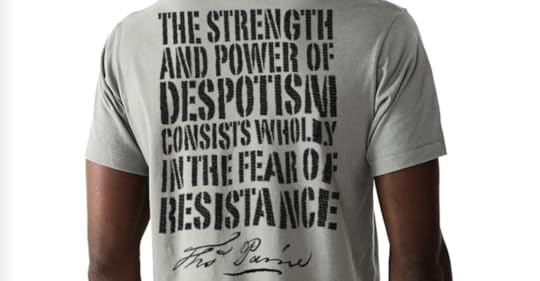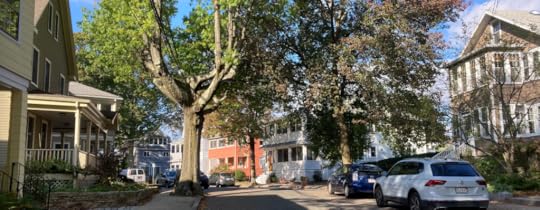Paul E. Fallon's Blog, page 19
January 19, 2022
On Rent Control: Part One—Legal History
The Joint Housing Committee of the Massachusetts Legislature recently held a virtual hearing on House Bill H.1378, a proposal to grant cities and towns the right to establish rent control. As a person who lived in a rent control apartment, then owned rent-controlled apartments, and now owns unregulated apartments, I have broad experience of the issue. This series explores the potential, and pitfalls, of rent-control as a mechanism to address our housing supply and affordability crisis.

A Brief History of Rent Control
The first rent control laws in the US were adopted in the 1920’s. They expanded in the wake of World War II, with a desire to ensure affordable housing for returning vets, primarily in large, coastal cities. The salient feature of rent control was establishing a maximum allowable rent for any dwelling. Across-the-board adjustments were indexed annually (similar to a COLA: Cost of Living Adjustment). The maximum allowable rent for a particular unit could also be increased when local rent control boards approved landlord petitions supported by capital improvements to their property.
The 1950’s economic boom created unprecedented construction and suburban expansion; rent control fell out of favor. The general perception was that people who lived in rent-controlled units enjoyed unfair advantage. Meanwhile housing stock deteriorated as owners of rent-controlled buildings, put off from battling rent control boards for meager increases, provided minimal maintenance.
In the 1970’s most cities with rent control shifted to a second-generation system: rent stabilization. Rent stabilization varies from rent control in one important way; the landlord can ‘reset’ the base rent when a tenant moves out. This offers financial incentives for landlords to maintain their property, while encouraging tenants to remain in place. An upside of rent stabilization was promoting more stable neighborhoods; a corresponding negative was landlords trying to get rid of long-term tenants. Many landlord/tenant relationships got ugly.
As economic theory swung from Keynesian to free-market in the 1990’s, both rent control and rent stabilization were denounced as proto-socialist relics that impeded real estate development in a supply-side world. By definition, those evaluations ignored the fundamental premise of rent control: that housing is a right, and we all benefit when everyone enjoys stable, secure places to live.
The legal mechanisms that determine whether rent control thrives or perishes are significant; they reflect conflicts between federal, state, and local authority that infect much of our political discourse to this day. Rent control laws are municipal: enacted by a city or town. Yet, the ‘authority’ to enact rent control rests with the states. Large cities, with majority tenant populations, often favor rent control; while state legislatures are less inclined to support laws portrayed as economic drags that benefit a select few.

The history of rent control in my city, Cambridge Massachusetts, is both representative and unique. Massachusetts was late to the rent control game: it did not pass enabling legislation until the early 1970’s. The City of Cambridge thereupon enacted a system of pure rent control rather than second generation rent stabilization. Every residential building in the city with four units or more (plus any that were not owner occupied) was registered, maximum allowable rents established, and increases for capital improvements or inflation granted upon approval of the Rent Control Board.
It didn’t take long for tales of outrageous inequity to surface: Harvard professors and city council members living in large apartments for less than $200 a month. Landlords tried to circumvent the law by flipping rental units to condos, only to have the city stiffen condo conversion requirements. Each side dug into their position; although, in a city of 70% renters, rent control advocates held the upper hand. Rent increases were notoriously stingy, and people who purchased condominiums listed on rent control rolls could not occupy their own units. Real estate tensions in the city were explosive.
By the 1990’s, most Massachusetts cites who had adopted rent control had abandoned it. Boston and Brookline exercised rent stabilization; only Cambridge maintained strict rent control. A ‘local’ group known as SPOA (Small Property Owner’s Association) came up with the brilliant, if not exactly small ‘d’ democratic idea, of a ballot initiative to overturn the enabling legislation: i.e. get rid of rent control in Cambridge by making it illegal throughout the entire state. In 1994, citizens from Massachusetts’ 351 cities and towns were able to determine the fate of a policy that only affected three localities.

Rent control was abolished by a statewide referendum vote of 51% to 49%. A series of endgame tactics by the city failed to preserve any elements of the system. Frank Duehay, the sole city councilor who voted to create rent control and also witness its demise said, “I have to ask, is it better to have something or is it better to have absolutely nothing?” Overnight, residential rents in Cambridge went from being highly regulated, to completely unregulated.
If ever there is a case study in which both sides lost through their inability to communicate and compromise, this is it. Compare the physical dilapidation and inequitable rents that accompanied Cambridge’s diverse and funky vibe during 25 years of rent control, with the immaculate yet unaffordable, culturally sanitized city we’ve created twenty-five years later. Rent control was neither fair nor beneficial. Unfettered rents have created a different set of inequities.
Next Up: Rent Control and Me
January 12, 2022
First Snow

Is there anything more delightful than first snow?
Ours arrived, an unassigned holiday inserted into the calendar, in the early morning of Friday January 7. I slept late and woke to a pixelated sky descending over the earth with lazy ease. No traffic noise. No children shuffling to school. My muscles loosened at the generous gift that little—actually nothing—would be expected of anyone today.
I watched accumulation on the deck railing: six inches; eight; as I devoured a pot of steel oats gussied up with leftover holiday cream plus cranberries, walnuts, cinnamon, and brown sugar. Basically: liquid cookies. The hearty oats stuck to my ribs all day.
By noon the snow had dwindled to flurries, so I tugged on my LL Bean boots and took to the shovel. I like to shovel, especially snow fluffy as this. The rhythm of scrape, hoist, and toss. The quietude of the city draped in a shroud.
City dwellers are disinclined to visit in each other’s homes. The measured distance between our interiors and whatever’s passing by is too small to afford causal drop-ins. In my thirty years here I can count on one hand the number of times I’ve been inside any of my neighbor’s houses. But we often encounter one another after a snow. We all have reason to be out. We are all working hard. Though we are not in a rush, so chat breaks are welcome.

I like to make it easy for pedestrians to traverse my domain, so I take care to shovel the full width of my sidewalk and clear away hard clods the street plows deposit on my busy corner. With responsible citizen duty done, I head out for a walk myself.
I relish meandering the city after a snowstorm. Property owners have a dozen hours to clear their walks; during the period of patchy clearing pedestrians claim side streets right down the middle. Though cars are surprisingly few; we are surprisingly many. Couples stroller their babies. Parents with school-age children tote discs to the hill at Fresh Pond. (Flexible Flyers seem to be curiosities of history.) Car owners brush off their hoods and fenders, and then dig under their wheels. “That looks like fun,” I observe as a woman with a long broom sweeps the top of her Subaru with balletic grace. “The first snow is always fun!” She smiles.
Her words are so true. The first snow is always the most fun, especially when it arrives with the morning, bestows a free day upon us all, and dissipates in time for a veil of sun to kick off the melt.
Each successive snow will be a bit less fun; a lot more hassle. Winter grinds long and cold. Which is why it’s so important to savor first snow and hold it dear in memory.

January 5, 2022
On January 6: The Wisdom of Thomas Paine

“These are the times that try men’s souls.”
We have no definitive proof that the opening line of Thomas Paine’s pamphlet, “The American Crisis,” published in the deepest dark of the American Revolution, directly inspired George Washington and his troops to cross the Delaware, surprise the British at Trenton, and change the momentum of the war.
“The summer soldier and the sunshine patriot will, in this crisis, shrink from the service of their country…”
As a man who has always viewed citizenship as a responsibility of heart and hand and mind, rather than of arms, I like to think that Thomas Paine’s words made as much difference as any musket.
“…but he that stands by it now, deserves the love and thanks of man and woman.”
This week marks the one-year anniversary of the most serious threat our democracy has ever faced. I do not pen those words lightly. We have endured a Civil War when states seceded from our Union; a Gilded Age of backroom political bosses; a Jim Crow era of vigilante action; and a purge on so-called Unamerican activities. I came of age during the era of Civil Rights, and can attest that the physical violence we laid upon each other during those years was far greater than that we witness now. So, why do I think the threat our or democracy on January 6 is so much worse?
During the 1960’s, citizens who had been left out of the promise of America clamored for the opportunity to fully participate—they wanted to get in. On January 6, 2020, already enfranchised citizens climbed the walls of our Capital to obstruct the democratic process—they wanted to keep others out.
“Tyranny, like hell, is not easily conquered…”
We live in a moment of unparalleled confusion; so much data, so much misinformation, so few shared truths. We have little faith in institutions, and less faith in each other.
“…yet we have this consolation…that the harder the conflict, the more glorious the triumph.”
Let us rise in this anniversary moment of a treasonous event and take action to ensure equality and justice for all. Let us acknowledge that despite falling short of our aspirations for nearly 250 years, we will strive, peacefully, to realize our truly remarkable American vision: that each of us will have equal voice in governing our nation.
“What we obtain too cheap, we esteem too lightly: it is dearness only that gives everything its value.”

December 29, 2021
Life is Short
A Twenty-first Century Myth

“Life is short,” we mutter as the calendar flips through these dark December days heading to another year. We believe our time on earth is brief, but that assumption doesn’t correlate with twenty-first century reality. Aside from Old Testament characters, which reportedly lived for centuries, people have never lived longer than we do today.
One signature statistic describes how the twentieth century transformed human existence: our lifespans increased by more than 25 years. The average American born in 1901 could expect to live to age 47. That same person born in 2000 could expect to celebrate 73 New Year’s Eves. After eons of incremental advances, lifespans leapt at a rate of three months per year throughout the developed world.
The United States was not alone in this accomplishment. Though we enjoyed the longest lives on earth through the 1970’s, other countries have since eclipsed American’s longevity. In this century, the rate of longevity extension has slowed, in some places, for some demographics, life expectancy has slipped. Yet, around the globe, more people are living longer than ever before.
Some plants and a few animals live longer than us. The bowhead whale, the longest living mammal, can blow his snout through two hundred winters; a number of tortoises born in 1850 are still alive today. An American born in that year had less than half the life expectancy we now enjoy. Actuarily, if I’d been born in 1850, I’d already be twenty years dead. Fortunately, since I’m 66 in 2021, Social Security estimates I’ve seventeen more years to carry on. I’m angling for even a few more.
Maybe life seems short because everyone gripes we’re so busy. Again the facts defy our protestations. According to the U.S. Department of Labor, the average person works a total of 3.54 hours a day, almost as much as the 2.83 hours we spend watching TV. We even manage to sleep more than eight hours a night, despite the bleary eyes around the office coffee pot on Monday mornings. Since our society focuses ‘work’ into an in intense period of active adulthood (when we’re also raising children and scrambling for economic security), averages don’t reflect the full spectrum of workaholics, or TV bingers. However, they do expose our human propensity to boast about busyness while downplaying our less productive pursuits.
The dual mantras of “busy” and “life is short,” offer psychological solace. Espousing busy, busy, busy, gives us purpose, while bemoaning that life is short excuses whatever we leave undone. Most of us alive today will thrive into our 70’s, many will pass 100, yet we still cling to the refrain that “life is short” because it’s a comforting soundtrack through our long journey.
If we think life is too short, then how long would we like to live? Science journalist David Ewing Duncan has asked more than 30,000 people to choose their optimal lifespan: 80 years, 120 years, 150 years, or forever. A solid 60% majority wished to live eighty years while less than one percent sought immortality. Despite what we say, we don’t really want to live much longer.
Most of the increase in our life expectancy is due to reductions in infant mortality. A person who survived to age 5 in 1901 had a good chance of reaching 60 or 70, as did folks in colonial America or Ancient Greece. Surviving those first five years was the tough part. These days, many more children survive infancy, but we’ve also increased every other phase of life. Childhood is longer, adolescence longer; extended middle age lasts into our sixties; triple digit elderly are becoming common.
Hippocrates started this myth in 400 B.C. when he wrote, “Life is short, the art long, opportunity fleeting, experiment treacherous, judgment difficult.” Apt words for a physician confronting an ill patient whose individual life may be soon over. But they are misconstrued when extrapolated to everyone. Imagine how different our outlook would be if we exclaimed, “Life is long, art eternal, opportunity abundant, experiment exciting, judgment clear.” What if, instead of fretting about life’s temporary nature, we acknowledge that we inhabit this earth for a long time; time that affords us leisure to explore, analyze, and evaluate before we act.
This New Year I’m abandoning the phrase, “Life is short.” Evidence demonstrates the contrary. Instead, I embrace our longevity as a gift as well as a challenge. I resolve to live with the long view in mind.
_ _ _ _
Image courtesy of the Nature Conservancy
December 22, 2021
I am Not in Charge
Its December 2021, an inauspicious year if ever there was, save one personal milestone. I have gotten further along in achieving last year’s new year’s resolution than ever before. What was my resolution? “I am not in charge.”’

At first glance I may not appear to be the kind of person who seeks to be in charge. In my professional life I eschewed most any title or formal role. I was never principal in a firm; hardly ever stamped a project as architect-of-record. Yet I carved out a mediating role that often made me center of attention.
“You are the best facilitator I ever met,” An administrator at Boston Medical Center told me when I announced my retirement, only a few months into a five-year major facility renewal. “But I can see why you’re moving on. That’s not the kind of thing one carves on a gravestone.” At age 58 I realized that I simply didn’t have the enthusiasm I needed—and Boston Medical Center deserved—to thread the nimble negotiations of who got fresh space and which services expanded. I’d steered clinicians, administrators, and patients toward consensus before on several large projects. I knew the success of any project hinges as much on perception as on construction, and I had a knack for making everyone feel heard; feel they came out ahead. The more I got folks vested in our design, the more they were more inclined to proclaim the result a success. Their success.
It was great fun, and I was good at it. Never titularly in charge. Always the go-to person to move forward. Having a general knowledge of all aspects of health care suited my curiosity, which is broad rather than deep, while juggling the politics, egos, and financial incentives of the American healthcare system catered to my puzzle-solving nature. I loved corralling all the players and horse trading them into agreement.

In the eight years since I retired, the satisfaction of being in charge, however conferred, is a difficult thing to yield. It comes naturally to me. No doubt, in part, a role that many educated white males simply assume.
Perhaps it was the 2020 pandemic, which shook everyone’s sense of control. Perhaps it was George Floyd’s murder, which stripped whatever sheen remained of American lip service to equality. Perhaps it was just the fatigue of our pointlessly divisive era. Whatever the reason, last December I decided to try and let go. Forfeit my kneejerk impulse to take charge.
It would be a lie to say that I succeeded every day in every way. But in total, I held my tongue more in 2021 than any other year of my life. I listened more, and I believe, listened better. I took more deep breaths as a matter of soothing. I apologized frequently, and meant it sincerely.
The world is not a better place for me stepping back, but it’s no worse either. Even my own little corner appears pretty unaffected by me acing a new year’s resolution. But the direction feels right to me. Retirement means stepping back rather than stepping in. Letting others seek you out rather than putting yourself out there. Exploring the broadest possible perspectives, and leaving the details to the next generation.

I’m pretty disappointed with the world that we, the Greatest Generation Once Removed, are bequeathing our children and grandchildren. Our hubris and greed have done to more to hasten the demise of humanity than any previous cohort. We salve our conscience by protesting that we did nothing more than build directly upon the foundations we inherited. Just like every generation before us. But such comfort is false. We knew the warnings: what we’re doing to our society; to our planet; and we scarcely changed course.
There is still a lot a person can do, when he’s no longer in charge. I can still learn and question and make connections. I can laugh and sing and cry, ride my bike and enjoy the train, eat healthy and exercise daily. Offer my voice, opinions, and knowledge to the next in line. Knowing full well they may be rejected: I am not in charge.
Notching down a few ladder rungs is not a reason to abandon or hide. Rather, it’s an opportunity to work differently, to live differently. To support what’s right moving forward without leading the charge.
_ _ _ _ _
Images from the cover of I AM NOT IN CHARGE by Ness Cannon
December 15, 2021
The Graffiti in our Minds

Spirits of anguish past and present are my companions as I tromp the carpet of dead leaves. At its peak, Metropolitan State Hospital, Massachusetts’ last and largest institution for mentally ill (built 1930), held 2,000 patients behind its Georgian Revival facades. Within: barred windows; hard tile; wards lined with metal frame beds. Easy to secure restraints.

The inhabitants of Metropolitan State Hospital, like its sister asylums, received inadequate care at best, cruel at worst. It closed in 1992, as the Commonwealth decentralized care of the mentally ill. It’s out of fashion to find any virtue in the way we locked up our crazies. Especially if you’re lucky enough to land in a cozy group home, where care is quite good. Less so, perhaps, if you’re among the throng of confused homeless loitering Mass and Cass, pressing against a cardboard lean-to to fend the winter wind.

Today, Metropolitan State’s extensive grounds are a nature preserve with meandering trails from Beaver Brook to the top of Mackerel Hill. The finest of the original structures have been transformed. A snazzy two-bedroom apartment, whose living/dining room used to house eight inpatient beds, rents for $2800 per month.

I wonder what ghosts inhabit those renovated wards; the spirits are keenly prescient along these open-air trails. In one ravine, the trail opens unto MetFern Cemetery, final resting places marked only by patient numbers plus a ‘C’ for Catholic or ‘P’ for Protestant. As the name implies, residents of both Metropolitan State and the neighboring Fernald School are buried here. Whatever improprieties were inflicted at Metropolitan were superseded at Fernald, a school for developmentally disabled boys used as a Eugenics testing ground. Conjure that gruesomeness.

Atop Mackerel Hill is an aging water tower. Dull grey and rust, except for the first six or eight feet from the base. Graffiti artists spray-paint angst on this psychotic ground. I ponder the images and words that can only be seen by those who trod the path; thick brush hides the color and doubt from cars passing by Trapelo Road. The sentiments might well reflect the mindset of previous residents; they don’t square with our mantras of healthy living. And yet each image draws a direct response from me. They resonate.

The gap between the formerly insane and the presently functioning may be small. Perhaps there is no gap at all.

December 1, 2021
Smoky Bar Man
A Tribute to Phil Saviano, 1952–2021
Front page, above the fold, in The Boston Globe. Feature length obit in The New York Times. Segments on major outlets—nationwide. I have only one friend whose death warrants such a blanket of coverage. Then again, media savvy Phil Saviano is also my only friend who would fully appreciate the deserved attention. By all means, click on the links and read the obituaries of this remarkable man. Or simply continue on for my personal tribute to a remarkable friend.
 Phil Saviano in Oaxaca Mexico in 2000
Phil Saviano in Oaxaca Mexico in 2000Summer 1995. My chronological calendar has flipped over to the big 4-0, but as a gay man, I am still a toddler. Two years since I came out. Therapy, support group, Boston Gay Men’s Chorus, boogie-down at the Napoleon Club’s Josephine Room until the 2 a.m. lights-up blinds us stragglers. I’d kissed a man, which represented progress. But when an acquaintance scolds, “Virginity is no virtue in the gay world,” it’s time to speed things up.
Personal ads fill the well-worn back pages of Bay Windows. I dislike phone chat, and so scrutinize columns for the tiny envelope symbol of those few seekers who welcome written response. Here’s one: Smoky Bar Man. Hardly sounds promising, but then again, opposites attract. I read and reread the carefully composed 25 words. Begin a letter of introduction. Reference the ad. Eventually notice it’s listed under the heading ‘Positive Attitudes.’ This guy has AIDS?
Among the differences between a 40-year-old newly-gay father with a pair of kinder-age children and the bulk of Boston’s gay community circa 1995 is zero direct experience with AIDS. Every gay man of my generation bore fresh wounds. They either had the virus or knew some who did. Everyone knew someone who’d died. They’d discarded the shame of sex=death to rally the activism of silence=death.
By the time I arrive on scene, means of transmission are well established, modes of protection understood. Avoiding the virus requires precaution, but the methods are clear. I don’t know anyone with AIDS, and never considered the logistics of dating someone with the virus. But what the heck, Smoky Bar Man has captured my attention.
“I got your letter. I’m impressed. No misspellings. Correct Punctuation. Call me back.”
Not the most promising answering machine message. But I return his call. The same night.
“Oh, heh. This isn’t a good time. My favorite show is about to start.”
Really? You prefer some TV show over talking to a man of correct punctuation? My inaugural experience in the personals confirms common consensus: guys who post ads are duds.
The next night, Phil calls back. When he relays enthusiasm for Leonard Cohen, I think this guy might be okay. When he divulges his love for Judy Collins, I want to meet him. When I learn that Phil actually knows Judy Collins, I am smitten. We talk for two hours. Perhaps my longest phone conversation ever.
Phil and I go on a date. A walk along Newbury Street, suitably public and chaste. Phil invites me for dinner. The simple casserole in plastic bowls is a welcome relief from the elaborate presentations I’ve encountered at other gay tables. Phil comes to my house; my children take an immediate shine.
By the time we met, the defining parameters of Phil Saviano’s life were history. His boyhood abuse by Father Holley. Contracting AIDS in 1984. Receiving a six-month life expectancy. His decision to stand up to the Catholic Church’s gag order. Founding SNAP (Survivor’s Network of those Abused by Priests). Signing up for every experimental AIDS treatment available. Being on magazine covers. Being in and out of the hospital. Plunging to a single-digit T-cell count. Living just above poverty, in awesome dignity.
The Phil I meet is healthy, handsome, wicked funny. His past recounted as a trove of adventure more than a burden of suffering. I’ve never known anyone of such fortitude. One night, finally, we make out on his couch. After few minutes we fell apart, laughing. “Sorry, Paul. You just don’t have the right teeth.” Phil’s the only gay man I ever meet whose singular fetish is teeth. Small, even, straight-lined kernels top and bottom melt the man. I have, well, pointy canines. Tooth contour aside, Phil and I are never destined to be lovers. So we became fine friends.
Over our twenty-five years Phil is mostly healthy, fiercely independent. His streength improves; his Mexican handicraft import business thrives. He weans off disability. Each December I go to his art-filled apartment to help wrap and ship the holiday rush. In 2000, Phil takes me on a buying trip to Pueblo, Oaxaca, and surrounding villages during his favorite celebration: Day of the Dead.

Phil possesses a rare ability: insight without judgement. “You live in your head.” He tells me one summer day as we share lunch on my deck. “You should start considering it an attribute.” I grew up in a family where solitude was viewed suspect. “Don’t be afraid; enjoy it.” That simple germ reveals a truth that decades of therapy never tapped. I mark the moment as a turning point in self-understanding.
Phil and I are typical guy friends. Years pass with no contact. Until some mutual interest prompts reconnection and we pick up where we left. Never an expectation, no recrimination. I’m at the hospital the day after Phil gets his new kidney. I can’t recall how I knew; certainly Phil would not make a special request.
“The problem with my life,” Phil jokes a couple years back, “is that I never planned for retirement.” Phil’s outlived his original death notice by more than thirty years. He’s confronted his boyhood trauma through action. He’s survived pneumonias and kidney failure and narcolepsy. The guy’s side-stepped the reaper more times than any cat. Never once do I hear Phil complain of his life’s lot. Nor see him cry. I scarcely recall a frown.
The last time I see Phil, he says, “When things get tough, I’ll call Lynn, and I have Jim.” I swallow the full meaning: I have dodged death so often, it will someday catch up with me; when I go, it will be on my terms; I’ve selected my best friend and devoted brother as the few people directly involved. Such a uniquely Phil way of expressing that I am not part of the inner circle, without making me feel outside.

I’ve spent the last few days remembering my friend, reliving our Mexican adventure. I will miss Phil, of course. But it’s hard to muster the same anguish I’d harbor for someone snapped away by accident. Phil lived and lived and lived. He lived well; he lived on his own terms. Far beyond anyone’s expectation or medicine’s explanation. His death feels less a tragedy than an opportunity to remember—and celebrate—the remarkable way this man thrived.
Thank you, Phil, for the gift you gave us all: the example of life so meaningful; so fully lived.
November 24, 2021
Giving Thanks (Despite Our Faults)

Thanksgiving.
Crisp leaves underfoot. Stinging fresh air. Roasted turkey. Glutinous stuffing. Fruity, creamy pies. Frantic airports. Family around the table. Football. Horns of plenty. Pilgrim pageants. The national folktale of our collective well-being. A day of gratitude.
Last year, two days in advance of celebrating a pandemic Thanksgiving stripped of communal trappings, I sat alone in my office and zoomed into SURJ (Showing Up for Racial Justice) base-group training. Our ever-gentle facilitator, offered a prompt. “I’d like to open our space for anyone who wants to share their struggle with what is coming up on Thursday.” Matoaka is so thoughtful, ran through my head, giving people an opportunity to express the disappointment of a non-traditional Thanksgiving.
Wrong, conventional white man. So wrong.

An outpouring followed, of rage and disgust that this so-called ‘holiday’ exists. That we actually celebrate our decimation of Native peoples with this fantasy of peaceful community. Further masking the fundamental reality of our nation: violence.
I listened to the anger, I heard the pain of women (I was the only male in our training group) who suffered Thanksgiving as yet another form of erasure and oppression. I learned about The National Day of Mourning, a fasting ritual held every Thanksgiving at Plymouth Rock to acknowledge the genocide of indigenous people.
I could not deny their truth or their anguish. But it didn’t resonate either. Yes: humans are cruel; power corrupts; and the winners write the history. But I cannot understand the value of agonizing our faults so deeply that they debilitate us. Rather, let us to enlarge our history to embrace voices silenced by simplistic myth.

I love Thanksgiving; I always have. Hands down, my favorite holiday. The least commercial, most collective celebration of our year. Acknowledging the blood seeped into the holiday’s origin story does not negate the grace embedded in giving thanks.
I give thanks for the abundance that blossoms when humans rise above base instinct; I revel in the bounty of coming together; I celebrate our potential: that one day the conqueror and the vanquished will embrace and move forward: in equity toward each other; in balance with our planet.
Happy Thanksgiving to all.
November 17, 2021
Who is My Neighbor?

I’m confident there’s something greater than us out there. Not a deity that directs our daily lives: that abdicates our individual responsibility. Nor something fashioned in our own image and likeness: that’s simply a narcissistic failure of imagination. I believe that Jesus Christ is the son of god. But so am I. And so are you. And so, from a religious perspective, I’m no Christian.
Yet I am culturally Christian. Steeped in its fundamental moral and ethical traditions. The Bible. The parables. The ten commandments. I don’t adhere to every fable: the celebration of the prodigal son at the expense of the steadfast one is simply appalling. Yet my moral compass points New Testament north. Less Hammurabi’s eye for an eye. More Gospel Matthew, bent toward forgiveness.
One cornerstone of cultural Christianity is, “Love thy neighbor as thyself.” I suppose in Palestine circa AD Zero, your neighbor was pretty easy to identify. The extents to which anyone walked was limited; everyone you met was your neighbor and it behooved you to treat them well. You had zilch influence on anyone beyond your immediate geography. They were out of scope.
The first part of the definition for ‘neighbor’ still holds. The people who live in my immediate proximity, who walk the same sidewalks and attend the same schools are certainly my neighbors. Beyond that, the definition gets muddy.

A typical blog post, authored by The Awkward Poser or pretty much anyone else, follows a predictable trajectory. A personal vignette illustrates a social condition, problem, or opportunity. Sprinkle in a bit of irony, a dose of humor, and resolve with refreshing insight. Keep it light, but not trite, in under 1000 words
This post does not follow that trajectory because, in truth, I have no idea where to draw the boundaries that define who is my neighbor. I am simply going to listicle the gradations as I understand them.

My neighbor is:
A person who occupies my immediate geographical and social sphere. Which, in my domain means they may not be white, but they are well-educated and affluent.A person who occupies my immediate geography but not my social sphere. There is a housing project four blocks from my house. I hardly interact with anyone who lives there.A person who lives in the city of Cambridge. Cambridge is only six square miles, but it includes over a hundred thousand people. How could I possibly love them all as myself?Every person who shares my political and social views. Is being a neighbor allowed to be easy?Everyone, regardless of their political and social views. That makes being a neighbor incredibly hard. How can we possibly love someone as ourself who is diametrically opposite ourselves? Even if we could love them, we’d have to love them in some other way.Every citizen of the United States. Aren’t we supposed to hold much in common?Every other person in the United States. The undocumented occupy the same space, right?Every person who wants to get into the United States. Is it our duty to share what is good and bad about the US of A with anyone, simply because they want to come in? If they are our neighbors and we are Biblically inclined, then we must.Every virtual person we encounter on the internet. Many are real; their entreaties and GoFundMe’s are sincere. But many are trolls or bots. Do neighbors have to be human?Every creature we influence on this earth. The birds, the bees, the pandas, the spotted owls. They are our neighbors in a geographic sense. But if I exert myself to their preservation, it is often at the expense of some other creature.
Thus, twenty centuries on, the Biblical imperative to love they neighbor as thyself is, at a minimum: exhausting; in reality: futile. There are too many of us making too competing demands. Call me callous, but I simply cannot care as much about an ill person who lives in Southeast Asia as I can about the man who lives down the street. At least I can bring my immediate neighbor a casserole or accompany him to the doctor. I can’t offer anything so tangible, so direct, to the person on the far side of the globe.
And yet, I cannot draw a line through my list and announce those above as my neighbors, those below outside my consideration. My moral compass wants to include everyone I encounter under the umbrella as my neighbor. The sheer number of encounters that bombard us in the twenty-first century tramples on that Biblical ideal.
November 10, 2021
$1.37 of Giddy Happiness

As a first order approximation, the amount of money a person spends is a good reflection of how sustainably they live. It’s not an exact correlation—environmentally negligent junk food costs a lot less than locally-grown produce—but the ratio tracks well for most human carvings and their planetary impacts.
I’ve never been much of a shopper, so spending little money isn’t difficult; and ever since my time in Haiti, I’ve made a personal parlor game of celebrating days of spending zero dollars. The Awkward Poser’s folly against the bombarding temptations of our consumer economy. Still, even I am not immune from the adrenaline jolt of savvy shopping.
It’d been a tough week. Three days of drizzly rain. A dear friend in Worcester in and out of the hospital, then back in. Finding a new tenant, off-season, after one suddenly moved. Jumping through hoops with the city arborists to remove a tree that’s shearing my neighbor’s retaining wall. A family member in Utah lost in a coma. The usual stuff of life: sliced grim.
I needed a walk. Fresh air. Heavy-breathing at the gym. I also needed spackle to repair damage in the empty apartment. $6.99 at Whites Ace Hardware in Porter Square.
I’d squirreled a $5 coupon issued from a different Ace Hardware in my wallet. “Will you accept this coupon from another Ace?
“Sure thing. It’s a corporate coupon. That will be $1.37.
“How’s that? The spackle’s $6.99; the coupon’s five bucks.”
“First, I applied the 10% senior discount. Then subtracted five dollars. The sales tax only apples to the remainder. That makes $1.37.”

“Wow.” Amazed how the clerk applied benefits I didn’t even know existed, and then tallied them to my best advantage. I walked out of store whistling a happy song. The emerging sun seemed a little brighter, my step a little lighter. The jaunty satisfaction of such sweet purchase. Was there ever a day when a tub of spackle delivered so much joy?
Of course, White’s Ace Hardware won as well. I may not shop often, but I won’t soon forget this great deal. I’ll be back.



